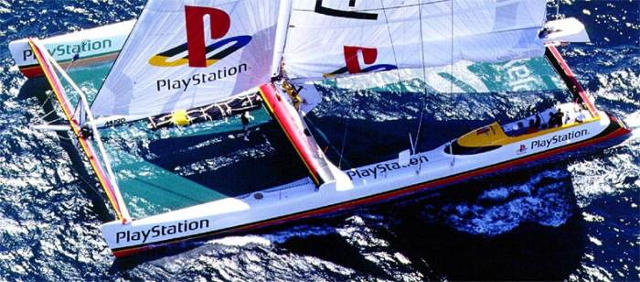
As I sit at my writing table, there are 70 mph gales and rain once again battering this house. As they have been, almost non-stop since late December (or at least it seems that way). On the 10th of December 2000, Pete Goss's 120-ft racing catamaran Team Phillips, costing 4.5 million pounds to build, was battered into submission by Atlantic storms and abandoned by its crew. As they climbed aboard the rescuing freighter, immediately my sympathies were with the crew.
Ernald Pearson, my friend and life-long Wharram sailor (he sailed with us from Sri Lanka to Oman in 1998) many years ago with a badly built (not by him) 50-ft Tehini, was likewise battered by mid-winter Atlantic seas and he, too, had to abandon his ship.
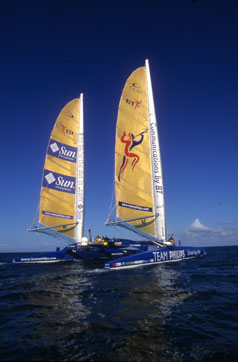
In the winter of 1989, Piet Viegers' Rapa Nui, the first built Pahi 63, was also abandoned in a December Atlantic gale. Piet Viegers had built his Pahi 63 almost single-handed. His would-be crew refused to sail from Holland at that time of the year, so he picked up a scratch crew of three, who had never sailed before. Arriving in our port of Falmouth, the local Navy Wharram contact, Tim Forrester, gave a very precise forecast when to sail before the next group of gales roared in. Unfortunately, Piet Viegers did not follow his advice, so three days after leaving Falmouth, he was out in the Bay of Biscay on the edge of the continental shelf - a place of horrible confused seas. In a wild winter Force 10+ gale, with more forecast.
The Falmouth Coastguard rang me up, apparently they were picking up a ship-to-ship radio conversation where Viegers was trying to off-load his now terrified useless crew, and hopefully get a replacement from the ship. If this sounds bizarre, Piet had been sailing the boat single-handedly for 36 hours. He got no offer of crew replacement, but only to take off the terrified crew. This he attempted, and then smashed his hard-earned Rapa Nui against the ship's side, and that was that. Winter Atlantic gales can be as bad as Cape Horn gales.
I am writing of these events, because in recent web-chat is emerging a belief that Wharram cats can survive any seas. Well, they have survived incredible storms, but we must never, ever get complacent. To survive the 'Savage Sea', your boat must be in top condition. You must be prepared, both mentally and in boat, sails and rigging.
From this personal and shared knowledge of the catamaran in heavy gale conditions, has arisen my interest in 'The Race'. A mad idea of a French multihull sailor, Bruno Peyron, the first man to circumnavigate the world in a sailing ship in less than 80 days. His idea (for the benefit of those who do not read yacht magazines) was simple: any size of non-power operated sail-handled boat, any type, any number of crew, starting from Barcelona, 31 December 2000.
Four years ago, when this idea was first put forward, a possible strong contender was Henk de Velde of Holland. Henk de Velde is a Wharram man, who in the early 80s sailed his 46-ft Classic Wharram Oro around the world. His vivid writing of his cyclone experience in the Indian Ocean is part of the Wharram sailors' heritage. After two single-handed round the world voyages on large racing catamarans, trying to beat the speed record, he had a proposed design by the great Australian racing multihull design office, father and now son 'The Crowther's'. This boat with Henk de Velde and a crew of Dutchmen had a sporting chance of winning, but its high cost meant no sponsors, no funding, no boat.
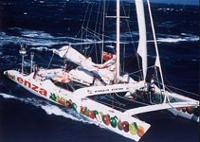
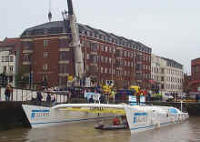
The American millionaire/adventurer, Steve Fossett, for The Race built in New Zealand a 125-ft long catamaran, that since launching has had constant re-builds. Cost unknown. On December 31st it started The Race, but after more structural problems, has pulled out, leaving 5 of the original 6 that started from Barcelona, 3 of these have been designed by the French designer Gilles Ollier. They are good boats, but one is already heading for Cape Town with 2 injured crew, a damaged fore beam and possible delamination. Leaving four boats still racing. One, a Polish craft also originally designed by Ollier, but old and short of money, then the last boat in the fleet, due to a handicapped start, is the Britton Tony Bullimore of Team Legato. That is the boat I am cheering on. Hopeless? Well, maybe. But I admire Tony's courage and determination, and Team Legato has part of her built by 'Wharram Builders'!
Team Legato began life in 1985 as Formula Tag, designed by Nigel Irens. It was built in Canada, with the help of a group of Wharram builders, who were the only suitable/trained boat builders around (Tim Ainley of Beluga was one of them). Somewhere in the extensively changed and developed Team Legato, is Wharram builders' handiwork.
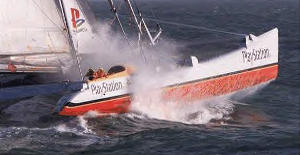
I first met Tony Bullimore in the 1978 Race Around Britain. He was struggling on an old trimaran, which had seen better days, but he got the racing bug. Next he was successfully winning races on a new Nigel Irens racing trimaran the Apricot. Yet whenever I met him, he was still the same warm-hearted sailor I had met in 1978. His world-wide recognised nail-biting adventure was, when single-handed, racing a monohull around the world, the keel fell off, the hull inverted, and after three days in a flooded capsized boat in the cold stormy Southern ocean, he was rescued just before death by an Australian warship. In a private visit to our Devoran base, he revealed more of this experience, which showed an inner mystic sensitivity not always apparent.
Tony was a man for sponsors to back. Nigel Irens, the racing multihull designer, the designer of Formula Tag (later rebuilt into the around-the-world Enza), was behind a modified larger Formula Tag/Enza, but all the British sponsorship money was soaked up in the Team Phillips design. At last, but almost too late, Tony Bullimore got financial help from Team Legato, to complete the design improvements to his boat. Racing is not the Wharram design scene, but we have to recognise courage, good sportsmanship when we see it. Tony Bullimore is our type of person, like most of us struggling to finance his dream. His boat has the work of Wharram builders within it. We from our office have sent him our best wishes and encouragement. It is lonely out there. It is hard when you began The Race 48 hours behind the others, and are behind the fleet trying to catch up. It takes a special bravery to keep going against the odds.
Provided we do not block up his e-mail service, if you feel as I do, why not e-mail him and his crew some words of encouragement. I think it would be appreciated and who knows - The Race is not over yet.
- James Wharram
